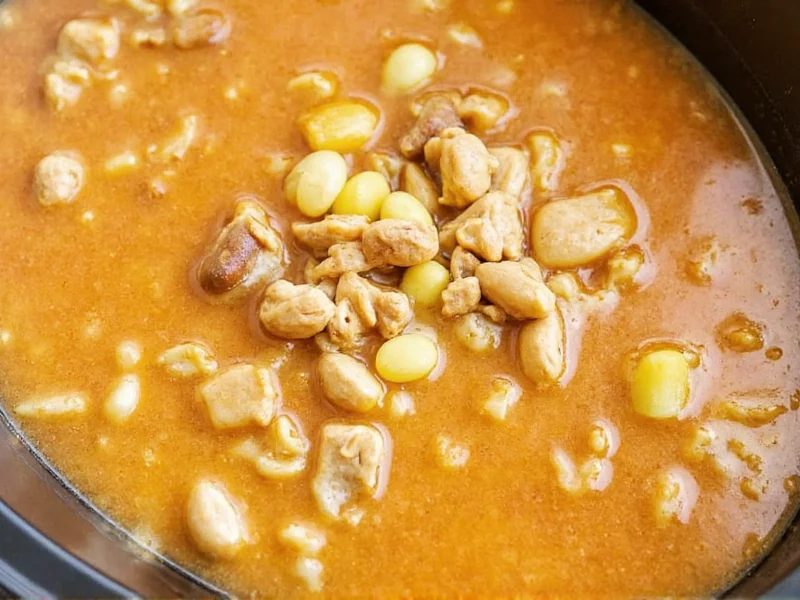Why Crockpot Chicken Soup Outperforms Stovetop Versions
Slow cooking transforms ordinary ingredients into extraordinary soup through gentle, consistent heat. Unlike stovetop methods that risk overcooking or uneven heating, crockpots maintain precise temperatures ideal for collagen breakdown in chicken bones. This process creates richer broth with superior mouthfeel and natural gelatin content. The sealed environment also preserves volatile aromatic compounds that would otherwise evaporate during rapid boiling.
Essential Ingredients and Their Roles
Quality ingredients form the foundation of exceptional crockpot chicken soup. Bone-in chicken pieces (thighs or a whole chicken) provide collagen that converts to gelatin during slow cooking. Mirepoix vegetables (carrots, celery, onions) should be freshly chopped - not pre-cut - to maintain flavor integrity. Use low-sodium broth to control salt levels, and always add fresh herbs during the final hour to preserve their delicate flavors.
| Cooking Method | Time Required | Texture Result | Flavor Development |
|---|---|---|---|
| Low (200°F/95°C) | 6-8 hours | Fall-off-the-bone tenderness | Deep, complex broth |
| High (300°F/150°C) | 3-4 hours | Firm but tender | Good but less developed |
| Stovetop Simmer | 1.5-2 hours | Risk of toughness | Less collagen extraction |
Step-by-Step Preparation Guide
Begin by arranging chicken pieces in the crockpot base, then layer vegetables evenly. Pour broth over ingredients without submerging completely - the vegetables will release additional liquid. Add whole peppercorns and bay leaves for subtle background notes. Cook uncovered for first 30 minutes on high to develop flavors, then reduce to low and cover. During the final hour, add pasta or grains to prevent overcooking. Always remove large chicken pieces before shredding to maintain broth clarity.
Variations for Dietary Preferences
Gluten-free adaptations work perfectly by substituting rice or quinoa for noodles. For keto versions, increase low-carb vegetables like zucchini and mushrooms while reducing carrots. Dairy-free preparations maintain richness through olive oil or avocado oil finishing. Immune-boosting variations incorporate ginger, turmeric, and extra garlic during the last two hours of cooking. Each variation maintains the core slow-cooking principle while accommodating specific nutritional needs.
Storage and Reheating Best Practices
Properly stored crockpot chicken soup maintains quality for 4-5 days in airtight containers. Freeze portions in labeled bags with soup level marked for optimal stacking. When reheating, add small amounts of water or broth to restore original consistency. Never boil reheated soup - gentle warming preserves texture. For best results, cool soup rapidly by placing container in ice water bath before refrigeration.
Troubleshooting Common Issues
Watery broth typically indicates insufficient collagen extraction - extend cooking time by 1-2 hours. Cloudy appearance often results from rapid boiling at start - maintain consistent low temperature. Bland flavor usually stems from inadequate seasoning layers - salt vegetables during preparation, not just at end. Meat toughness suggests improper temperature - verify crockpot maintains at least 195°F (90°C) throughout cooking cycle. Always use a thermometer to confirm internal temperatures.
Nutritional Benefits of Slow-Cooked Chicken Soup
Homemade crockpot chicken soup delivers significant nutritional advantages over canned alternatives. The slow extraction process yields higher levels of bioavailable minerals from bones. Natural gelatin content supports joint health and digestion. Customizable sodium levels accommodate dietary restrictions. Vegetable-rich versions provide diverse phytonutrients. The cooking method preserves more vitamins than rapid boiling. Each serving typically contains 200-300 calories depending on ingredients, with substantial protein content from properly cooked chicken.
Can I use frozen chicken in crockpot chicken soup?
Yes, but increase cooking time by 1-2 hours. Place frozen chicken at bottom of crockpot with extra 1/2 cup liquid to facilitate thawing. Check internal temperature reaches 165°F (74°C) before serving. Never cook frozen chicken on low setting initially as it may spend too long in danger zone temperature range.
How do I prevent vegetables from becoming mushy?
Add root vegetables at beginning but include softer vegetables like peas or spinach during last 30-60 minutes. Cut vegetables uniformly to ensure even cooking. For noodle soups, cook pasta separately and add to individual servings. Maintain consistent low temperature rather than high heat which accelerates vegetable breakdown.
What's the best way to store leftovers?
Cool soup rapidly in shallow containers before refrigerating. Store broth and solids separately for maximum freshness. Use airtight containers with headspace for expansion if freezing. Properly stored soup maintains quality for 4-5 days refrigerated or 4-6 months frozen. Always reheat to 165°F (74°C) before serving.
Can I make this recipe vegetarian?
Absolutely. Substitute chicken with mushrooms and extra root vegetables for umami depth. Use vegetable broth instead of chicken broth. Add a Parmesan rind during cooking for savory notes (remove before serving). Include miso paste during final 30 minutes for protein richness. The slow cooking process develops complex flavors even without meat.
Why does my crockpot soup taste bland?
Blandness usually results from insufficient seasoning layers. Salt vegetables during preparation, not just at the end. Add acid (lemon juice or vinegar) at serving to brighten flavors. Include umami boosters like tomato paste or soy sauce during cooking. Remember that flavors concentrate during slow cooking - underseason slightly at start. Always taste and adjust seasoning during final 30 minutes.











 浙公网安备
33010002000092号
浙公网安备
33010002000092号 浙B2-20120091-4
浙B2-20120091-4